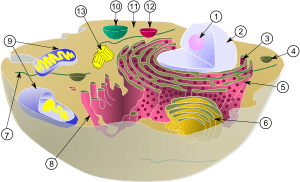Organelle facts for kids

In cell biology, an organelle is a tiny part inside a cell that has a special job to do. Think of them like the organs in your body, but much, much smaller!
Most organelles have their own thin membrane around them. This membrane helps keep their contents separate from the rest of the cell. Most of these tiny parts float in the cytoplasm, which is the jelly-like substance filling the cell.
Scientists find organelles by looking at cells through powerful microscopes. They can also separate them from the rest of the cell to study them.
There are many types of organelles, especially in eukaryotic cells. These are cells that have a true nucleus. For a long time, people thought prokaryotic cells (simpler cells without a nucleus, like bacteria) didn't have organelles. But now we know some do! These are different from eukaryotic organelles and don't have membranes around them. They are called bacterial microcompartments.
Contents
What is an Organelle?
The word "organelle" is used for cell parts that are surrounded by one or two membranes. These membranes are like tiny walls. They are made of a special material called a lipid bilayer with some proteins mixed in. This wall keeps the tiny ions and molecules inside the organelle from mixing with everything else around it.
However, sometimes the word "organelle" is also used for important cell parts that don't have a membrane. These are like large groups of macromolecules (big molecules) that work together. Many of these are mostly made of proteins.
Some examples of these non-membrane-bound structures include:
- Ribosomes: These are like tiny factories that build proteins.
- Cytoskeleton: This is a network of tiny fibers that gives the cell its shape and helps it move.
- Nucleolus: This is a part inside the nucleus that helps make ribosomes.
How Organelles Came to Be
Some organelles, like mitochondria and chloroplasts, have two membranes and their own DNA. Scientists believe they started out as tiny, independent prokaryotic organisms. These tiny organisms were either eaten by a larger cell or invaded it. Instead of being digested, they stayed inside and became a helpful part of the host cell. This idea is called the endosymbiotic theory.
Eukaryotic Organelles
Eukaryotic cells are complex and have many different organelles, each with a special job.
Main Organelles in Eukaryotic Cells
Here are some of the most important organelles found in eukaryotic cells:
- Chloroplasts (plastids): These are found in plants and some other organisms. They are like tiny solar panels, using sunlight to make food through photosynthesis. They have two membranes and their own DNA.
- Endoplasmic reticulum: This is a network of membranes that helps make and fold new proteins. It also helps make lipids (fats). There are two types: rough ER (which has ribosomes on it) and smooth ER.
- Golgi apparatus: This organelle is like the cell's post office. It sorts, changes, and packages proteins and lipids into tiny packages called vesicles.
- Mitochondrion: Often called the "powerhouse" of the cell. It makes energy for the cell to use. It has two membranes and its own DNA.
- Nucleus: This is the control center of the cell. It holds most of the cell's DNA and controls what the cell does. It has a double membrane.
- Vacuole: This is like a storage sac in the cell. It can store water, nutrients, or waste. It helps keep the cell balanced.
Other Important Eukaryotic Organelles
There are many other organelles and cell parts in eukaryotic cells, each with a specific role:
- Centriole: These are involved in cell division in animal cells.
- Cilium: These are tiny, hair-like structures on the outside of some cells that help them move or move things around them.
- Lysosome: These are like the cell's recycling centers. They break down waste materials and old cell parts.
- Peroxisome: These help break down fatty acids and detoxify harmful substances.
- Ribosome: These are tiny structures that read genetic instructions (RNA) and build proteins.
- Vesicle: These are small sacs that transport materials around the cell or store them.
Prokaryotic Organelles
Prokaryotic cells are simpler than eukaryotic cells. They were once thought to have no internal parts enclosed by membranes. However, we now know that some prokaryotes do have special compartments.
These compartments are usually surrounded by a shell of proteins, not a lipid membrane. Some examples include:
- Carboxysomes: These are found in some bacteria and help them turn carbon dioxide into food.
- Magnetosomes: These are found in some bacteria and help them sense the Earth's magnetic field.
- Nucleoid: This is where the prokaryotic cell's DNA is located. It's not a true nucleus because it doesn't have a membrane around it.
- Ribosome: Like in eukaryotic cells, prokaryotes also have ribosomes to make proteins.
Images for kids
See also
 In Spanish: Orgánulo para niños
In Spanish: Orgánulo para niños


